Cloud is acknowledged as facilitating “speed-to-market” – and for its capacity to drive enterprise agility. It is because cloud helps speedy experimentation and innovation by permitting firms to shortly attempt to even undertake new options with out important up-front prices. The Cloud could be a extremely agile wrapper round completely different methods, completely different conduct and bringing all of it collectively in an engagement cycle. By altering the way in which folks work together with know-how, cloud allows new types of shopper engagement, increase collaboration throughout the worth chain and convey innovation to firms’ core enterprise fashions.
10 Myths about Cloud Computing

No. 1: Cloud is all the time about cash
The prevalent fable concerning the cloud is that it all the time saves cash. That is generally the case, however there are lots of different causes for migrating to the cloud, the commonest of which is for agility.
All enterprise choices, together with these about cloud, are in the end about cash. Even when agility is the final word objective, price remains to be a priority. Don’t assume you’ll get monetary savings until you will have completed the onerous work of truthfully analyzing your scenario.
Make the most of whole price of possession and different fashions on a case-by-case foundation. Section cloud into use instances. Look past price points. You will need to be sure that the enterprise doesn’t have unrealistic price saving expectations that aren’t delivered upon.
No. 2: You must be cloud to be good
Are you “cloud-washing?” Cloud-washing, or the tendency to name issues cloud that aren’t, could also be unintentional and a results of reputable confusion. However IT organizations and distributors name many issues cloud as a part of their efforts to realize funding, make gross sales, and meet ill-defined cloud calls for and techniques. This leads to the parable that an IT services or products have to be cloud to be good.
Slightly than counting on cloud-washing, name issues what they’re. Many different capabilities, comparable to automation and virtualization, are sturdy sufficient to face on their very own.
No. 3: Cloud must be used for every thing
Cloud is a superb match for some use instances, comparable to extremely variable or unpredictable workloads or for the place self-service provisioning is essential. Nevertheless, not all purposes and workloads are a match for cloud. For instance, until clear price financial savings could be realized, transferring a legacy utility is mostly not a superb use case.
The cloud might not profit all workloads equally. Don’t be afraid to suggest noncloud options when acceptable.
No. 4: “The CEO stated so” is a cloud technique
“The CIO,” “the board” or another elusive supply can take the place of the CEO on this fable. Many firms nonetheless don’t have a cloud technique. That cloud technique must be primarily based on sound enterprise targets and real looking expectations.
A cloud technique must be greater than a mandate — it ought to determine enterprise targets and map potential advantages of the cloud again to them. Cloud must be considered a method to an finish. The top have to be specified first.
No. 5: We’d like one cloud technique or vendor
Even with extra curiosity in multicloud as we speak, many companies nonetheless want simplicity. Nevertheless, cloud computing is simply not one factor, and a cloud technique must be primarily based on this actuality. Cloud providers are broad and span a number of ranges, fashions, scope and purposes.
A cloud technique should be capable of accommodate the usage of increasingly more cloud providers. The group wants to comprehend that it is going to be comparatively not possible to get every thing from one vendor. A single cloud technique is sensible provided that it makes use of a call framework that permits for and expects a number of solutions.
6. Multi-cloud solves vendor lock-in and different administration challenges
Many enterprises consider in the event that they hedge deployments throughout a number of clouds, they keep away from vendor lock-in to a major cloud infrastructure supplier, Roberts stated. This perception is perpetuated by a number of third-party software program distributors and consultancy corporations.
On paper, it is sensible and is a typical IT apply. But, as soon as customers begin to deploy a multi-cloud technique, they may face quite a few challenges, comparable to safety, compliance and value administration, that would offset the advantages of decreased vendor lock-in dangers.
7. Containers all the time ease multi-cloud deployments
Containers and Kubernetes clusters could make it simpler emigrate purposes throughout clouds, and lots of executives consider these abstractions put together the purposes for multi-cloud eventualities.
“The cruel actuality is that not each workload can or must be containerized,” Feeney stated.
The additional away a legacy workload is from a 12-factor app, the much less seemingly it may run in manufacturing in a container. Solely take into account multi-cloud within the context of SaaS or a poly-cloud technique that separates workloads throughout cloud platforms, comparable to Google for machine studying, AWS for app deployment and Azure for .NET purposes. Enterprises greatest understand the advantages of cloud once they go deep on a selected platform and use its native providers.
8. Cloud is much less safe than on-premises methods
Knowledge breaches within the cloud get lots of consideration, however on the whole this public cloud safety fable merely isn’t true. AWS, Microsoft, Google and different main cloud suppliers are hyperfocused on safety and frequently carry out exterior auditing to make sure full compliance and certification for his or her infrastructure.
On the software program stage, suppliers apply safety greatest practices and use a variety of applied sciences, from firewalls and intrusion prevention to knowledge loss prevention and rootkit detection primarily based on machine studying. Nevertheless, IT professionals should nonetheless set insurance policies and configure purposes correctly.
“Whereas the general public cloud could be safer, it’s a shared accountability,” stated Ashish Thusoo, co-founder and CEO of Qubole, a cloud knowledge platform.
9. Cloud knowledge is public
“As a result of the time period public is used, many customers have the misunderstanding that the info that they retailer within the cloud is straightforward to get and isn’t personal,” stated Engin Kirda, co-founder and chief architect at Lastline, a community safety supplier.
Whereas it’s true that knowledge hosted at no cost is usually analyzed and used for advertising functions by firms comparable to Fb or Gmail, pay-to-play public cloud suppliers have sturdy knowledge safety and privateness ensures as part of their enterprise fashions. It’s within the supplier’s greatest curiosity to make the cloud as safe as attainable.
10. Customers lose management of their cloud knowledge
Whereas it’s onerous to debunk this public cloud fable, Erez Berkner, CEO of Lumigo, a serverless monitoring platform, believes not one of the main cloud service suppliers would danger their popularity to spy on clients, because the implications might be dangerous to their enterprise. Actually, they’ve elevated methods to see their exercise — Google’s Entry Transparency service, for instance, allows enterprises to see the seller’s actions of their clouds.
The identical goes for the place knowledge is saved within the cloud. Enterprise clients typically fail to comprehend that numerous configurations make it attainable to completely limit the place their knowledge resides, which may alleviate among the nervousness, Roberts stated.










